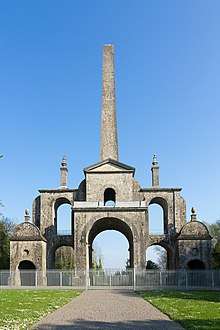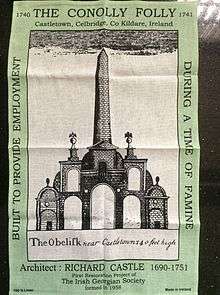Conolly's Folly
The Conolly Folly (Irish: Baois Uí Chongaile), a.k.a. The Obelisk, is an obelisk structure and National Monument located near Maynooth, County Kildare, Ireland.
| Baois Uí Chongaile | |
 Connlly's folly as of May 2016 | |
 Location in Ireland | |
| Coordinates | 53.3690°N 6.5605°W |
|---|---|
| Location | Barrogstown West, Celbridge, County Kildare, Ireland |
| Type | Arch structure with Obelisk |
| Height | 42 m (138 ft) |
| Completion date | 1740[1] |
| Dedicated to | William Conolly |
History
The folly was built just outside Castletown Estate (containing Castletown House), which contains two follies, both commissioned by Katherine Conolly, the philanthropic widow of Speaker William Conolly. It was built at a cost of £400 to provide employment for the poor of Celbridge when the famine of 1740–41 was at its worst. The obelisk was built in 1740 after a particularly severe winter. As a folly, it could be seen from the back of Castletown some 4 kilometres (2.5 miles) away and it is built exactly perpendicular to the centre of the house. It was intended to mark the rear entrance gateway to Castletown house in conjunction with an avenue leading to the house.
The folly was built on land that was near to, but not on, the Conolly estate. It therefore belonged to neighbouring Carton, the home of the FitzGerald family, Dukes of Leinster.
Designed by Richard Castle,[2] it is 42 metres (140 feet) high and is composed of several arches, adorned by stone pineapples and eagles, topped by a massive obelisk pillar. It was restored in 1961-65 by the Irish Georgian Society, and underneath is the grave of Mariga, first wife of Desmond Guinness of Leixlip Castle.
The folly, on its 5 acres of woodland, was acquired in 1968 thanks to American donor Rose Saul Zalles.[3] Its restoration was the Society's first major project.
It is now in the care of the Office of Public Works (OPW). A more modern gate prevents access to the folly.

Spelling
The name Conolly is used, rather than the more common spelling Connolly, as it was the spelling used by William Conolly and by all his descendants. It derived from the Irish 'Ui Conghaile'.[4][5]
See also
References
- Nolan W.; McGrath T., eds. (2006). Kildare : history and society. Kildare History and Society. pp. 327–348. ISBN 978-0-906602-57-7.
- James Kelly, ed. (2018). The Cambridge History of Ireland: Volume 3, 1730–1880. Cambridge University Press. ISBN 9781107115200.
Richard Castle [..] designed arresting structures for his clients' demesnes, most notably the vast Conolly folly built by Katherine Conolly as a relief work during the famine year of 1741
- "Obituary". Washington Post. 17 May 1987.
Mrs. Zalles, who often traveled to Ireland, established the Celtic Cultural Program at Georgetown University in 1981, and donated a 6,000-volume collection on Celtic history. She also was a member of the Georgian Society, an organization concerned with the restoration of Irish manor houses and castles.
- "William Conolly". Dictionary of National Biography. Archived from the original on 30 September 2007. Retrieved 7 March 2007.
- "The Conolly Papers]". Public Record Office of Northern Ireland. Archived from the original on 27 September 2007. Retrieved 7 March 2007.
External links
- Fantastic Follies (Photos of well known Irish Follies)
- Description of the Obelisk